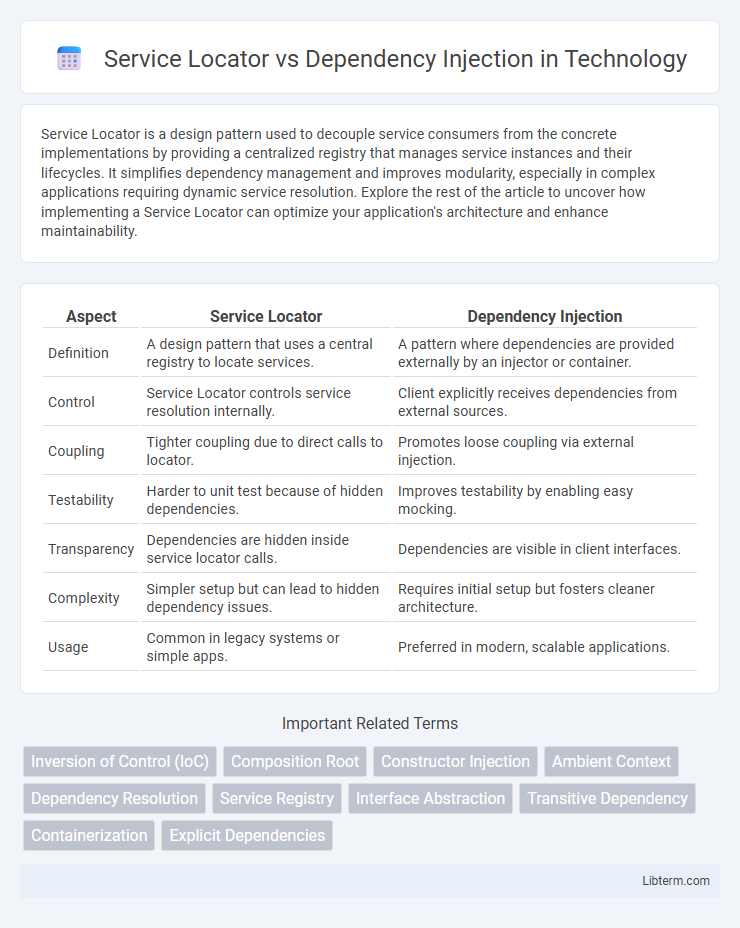Service Locator is a design pattern used to decouple service consumers from the concrete implementations by providing a centralized registry that manages service instances and their lifecycles. It simplifies dependency management and improves modularity, especially in complex applications requiring dynamic service resolution. Explore the rest of the article to uncover how implementing a Service Locator can optimize your application's architecture and enhance maintainability.
Table of Comparison
| Aspect | Service Locator | Dependency Injection |
|---|---|---|
| Definition | A design pattern that uses a central registry to locate services. | A pattern where dependencies are provided externally by an injector or container. |
| Control | Service Locator controls service resolution internally. | Client explicitly receives dependencies from external sources. |
| Coupling | Tighter coupling due to direct calls to locator. | Promotes loose coupling via external injection. |
| Testability | Harder to unit test because of hidden dependencies. | Improves testability by enabling easy mocking. |
| Transparency | Dependencies are hidden inside service locator calls. | Dependencies are visible in client interfaces. |
| Complexity | Simpler setup but can lead to hidden dependency issues. | Requires initial setup but fosters cleaner architecture. |
| Usage | Common in legacy systems or simple apps. | Preferred in modern, scalable applications. |
Introduction to Service Locator and Dependency Injection
Service Locator is a design pattern that centralizes the logic for obtaining service instances, allowing components to request dependencies from a registry or container. Dependency Injection involves passing dependencies directly into a component, promoting loose coupling and easier testing by externalizing the creation process. Both patterns aim to manage object dependencies effectively but differ in control flow and transparency of dependency resolution.
Core Concepts and Definitions
Service Locator centralizes the retrieval of service instances through a registry that components query at runtime, enabling dynamic resolution but often leading to hidden dependencies. Dependency Injection explicitly provides required services to components via constructors, setters, or interfaces, promoting clear dependency relationships and easier testing. Both patterns manage object dependencies but differ in control flow: Service Locator pulls dependencies on demand, whereas Dependency Injection pushes them during object creation or initialization.
How Service Locator Works
Service Locator operates through a centralized registry that holds service instances, allowing clients to request dependencies by querying this locator. It abstracts the creation and lookup process by providing a single point to retrieve services without requiring explicit knowledge of their instantiation. This pattern can lead to hidden dependencies and reduced code clarity since service retrieval happens internally rather than being passed explicitly.
How Dependency Injection Works
Dependency Injection (DI) works by supplying an object's dependencies through external means rather than the object creating them internally, promoting loose coupling and enhancing testability. It typically uses frameworks or containers to automatically resolve and inject required services during object instantiation, leveraging constructor, setter, or interface injection methods. This approach contrasts with Service Locator, as DI makes dependencies explicit and simplifies managing object graphs in complex applications.
Key Differences Between Service Locator and Dependency Injection
Service Locator centralizes the logic for obtaining service instances, requiring components to query the locator explicitly, which can obscure dependencies and complicate testing. Dependency Injection provides dependencies directly to components, promoting explicit dependency declaration, better modularity, and improved testability. The key difference lies in control of dependency creation: Service Locator hides it inside the locator, while Dependency Injection makes dependencies visible and manageable through constructor or setter injection.
Pros and Cons of Service Locator Pattern
The Service Locator pattern centralizes dependency management by providing a single access point to service instances, simplifying object creation and reducing constructor complexity. However, it obscures class dependencies, making the code less transparent and harder to test due to hidden service retrieval. Relying on a global service registry can also lead to tight coupling and decreased flexibility compared to Dependency Injection, which promotes clearer dependency contracts and easier unit testing.
Pros and Cons of Dependency Injection Pattern
Dependency Injection improves code modularity and testability by decoupling class dependencies, enabling easier substitution of implementations during testing. It can increase code clarity by making dependencies explicit through constructor or setter injection, yet may introduce complexity with configuration and dependency management in larger applications. Overuse or improper implementation can lead to difficulties in tracing dependency flows and potential performance overhead due to extensive use of reflection or container lookups.
Use Cases and Ideal Scenarios
Service Locator is ideal for legacy codebases and scenarios requiring centralized service retrieval without exposing dependencies explicitly, making it suitable for quick implementations and frameworks with limited support for dependency injection. Dependency Injection excels in modern applications demanding clear dependency management, improved testability, and loose coupling, especially in complex systems where explicit contracts and inversion of control enhance maintainability. Use Dependency Injection in large-scale applications or microservices architectures for better scalability, while Service Locator fits simpler projects or gradual refactoring efforts.
Common Pitfalls and Best Practices
Service Locator often leads to hidden dependencies, making code harder to maintain and test, as it obscures object creation and coupling. Dependency Injection promotes clearer architecture by explicitly defining dependencies, but misuse can cause over-injection or complex constructor hierarchies. Best practices recommend favoring Dependency Injection for transparency and testability, avoiding Service Locator's global state issues, and using interfaces or abstractions to decouple components effectively.
Conclusion: Choosing the Right Approach
Selecting between Service Locator and Dependency Injection hinges on project complexity and maintainability needs. Dependency Injection promotes clearer code structure and easier testing by explicitly defining dependencies, making it ideal for scalable, modular applications. Service Locator may suit simpler projects but can obscure dependencies, potentially increasing technical debt and reducing code transparency.
Service Locator Infographic

 libterm.com
libterm.com